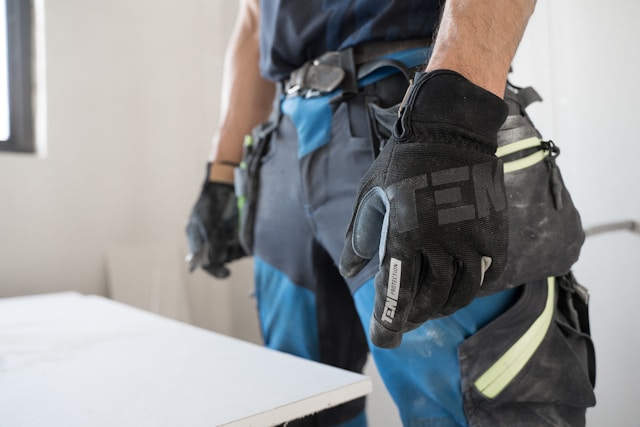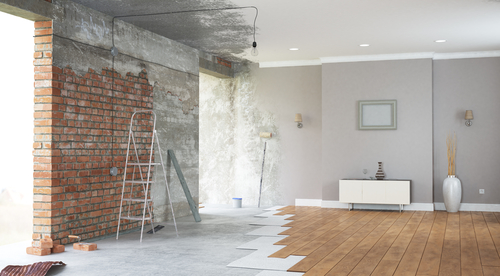Rendering and resurfacing are essential processes in construction and home improvement that maintain and enhance the appearance and durability of vertical and horizontal surfaces.

What is Rendering?
Rendering involves applying a layer of plaster, cement, lime, acrylic-based compounds or other materials to the exterior structural walls. This layer acts as a protective coating, safeguarding the underlying structure from weather damage whilst enhancing its aesthetic appeal. Put simply, render is a plaster that forms the outermost layer in an External Wall Insulation (EWI) system, offering both visual aesthetics and protection from the elements. An EWI system consists of two primary layers: insulation and a decorative render. This system involves attaching insulation to the exterior of the building, followed by a layer of render applied over the insulation. The render can be made from either mineral or synthetic materials, providing durability and weather resistance. This application not only protects the enclosed insulation from harsh weather conditions but also allows building owners to modify the external appearance by adjusting the texture and finish of the original surface to meet various aesthetic preferences. A high-quality render functions as a barrier against various weather elements, helping to prevent water ingress, which can lead to problems such as mould growth and future structural damage. Furthermore, certain rendering materials can enhance insulation properties, contributing to the building’s energy efficiency by maintaining a comfortable indoor temperature and keeping spaces warmer in winter and cooler in summer. It is also used in acoustic insulation.
Rendering is commonly used on brick, concrete, or stone surfaces.
Are There Different Types of Rendering?
There are four main types of rendering, being:
- Cement Rendering: A blend of sand, cement, and lime, cement rendering is the most traditional rendering method. It offers a strong and durable finish but often requires sealing or painting to achieve the desired aesthetic finish.
- Acrylic Rendering: This type utilises acrylic in its composition. Acrylic is a type of plastic, but not all plastic is acrylic. Acrylic is a petroleum-based thermoplastic made from methyl methacrylate (MMA) and/or poly methyl methacrylate (PMMA). It’s also known as polyacrylate. Acrylic rendering is highly flexible, crack-resistant, and available in many finishes and textures, making it a popular choice for both traditional and modern applications.
- Polymer Rendering: This pre-mixed, ready-to-use option includes polymers and other additives to enhance its durability and weather resistance. Polymer rendering provides a resilient finish that stands up well against the elements due to its strength, flexibility, and heat resistance, and it is also recyclable.
- Lime Rendering: An eco-friendly choice, lime rendering is breathable and particularly suitable for older buildings. It effectively prevents moisture build-up, helping to maintain the integrity of historic structures whilst allowing them to “breathe”.
What is Resurfacing?
Resurfacing is the process of applying a fresh layer of material over an existing surface to enhance its appearance and functionality. Common materials used in resurfacing include concrete, tar, asphalt, and specialised coatings. This technique is particularly effective for restoring and rejuvenating driveways, parking areas, pavements, and even walls and ceilings. Unlike rendering, which focuses on adding a new layer, resurfacing primarily addresses and repairs existing damage, resulting in a refreshed, safer, and more visually appealing surface.
There are two primary materials used for resurfacing walls and ceilings:
- Plaster: A versatile building material that can be applied to walls and ceilings for both protective and decorative purposes. For instance, small holes in plaster walls can be repaired with patching plaster, which can then be sanded smooth and painted over for a seamless finish.
- Fibreglass Matt: This technique is ideal for resurfacing old or damaged plaster walls and ceilings. It adheres to textured surfaces, drywall that has sustained damage, and above-grade block walls, providing a durable and smooth finish.
What Are the Benefits of Resurfacing?
Resurfacing has many benefits, including:
- It is cost-effective. Resurfacing offers a more affordable alternative to tearing out and completely replacing old surfaces, making it an economical choice for revitalising worn-out areas. It allows property owners to achieve a like-new appearance without the expense and disruption of extensive renovations.
- As such, it is more sustainable, as it reduces waste by restoring existing structures and materials.
- It offers enhanced durability through repairing and strengthening surfaces, thereby extending their functionality and lifespan.
- It allows for visual upgrades, providing a fresh, modern look without extensive building renovations.
- Resurfacing provides quick transformations, as the whole process can often be completed in a relatively short timeframe, minimising disruption for homeowners and businesses whilst delivering immediate visual enhancements.
- Resurfacing is versatile, as it can be applied in a wide range of settings, from residential and commercial spaces to industrial environments, allowing for flexibility in design and application. Many resurfacing materials are manufactured for longevity, offering a resilient finish that can resist fading, cracking, and other forms of wear and tear, ensuring a durable option.
Resurfacing Applications
Resurfacing can be applied in the following situations:
Concrete Resurfacing: Typically used for driveways, patios, and floors, this process involves applying a thin overlay or coating that repairs cracks and enhances the surface’s durability. Tar/Asphalt Resurfacing: Commonly used for roads and pathways to extend the lifespan of these surfaces while improving their overall functionality and safety. It is very useful in Pool Resurfacing, where the focus is on repairing and renewing the surfaces of swimming pools, significantly enhancing safety, functionality and visual appeal. Wall Resurfacing: Ideal for addressing issues like chipped or faded paint, cracks, gouges, or outdated designs such as textured and rough-surface walls, wall resurfacing revitalises interior and exterior walls, restoring their aesthetic and structural integrity.
Overall, resurfacing is a practical solution for enhancing the longevity and aesthetic appeal of various surfaces in your home or commercial space. This option renews worn-out or damaged surfaces. It covers imperfections, cracks, and stains, giving the surface a fresh, clean look.
When to Consider Rendering and Resurfacing
Both rendering and resurfacing are effective methods for rejuvenating a property but understanding which one to choose is crucial. Rendering is a good choice when dealing with exterior walls that are weathered, cracked, or in need of a fresh cosmetic transformation. On the other hand, resurfacing is best suited for surfaces that have become worn or damaged but don’t require complete replacement, since this approach focuses on repairs and revitalisation.
So, To Summarise …
Whether you’re aiming to enhance your home’s curb appeal with rendering or restore the aesthetic, safety and functionality of a surface through resurfacing, both options provide effective solutions. Investing in these processes not only beautifies your property but also safeguards and enhances its value for years to come.
